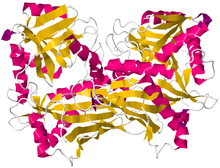| Branched-chain amino acid aminotransferase | |||||||
|---|---|---|---|---|---|---|---|
 Crystallographic structure of branched-chain-amino-acid aminotransferase from Mycobacterium smegmatis[1] | |||||||
| Identifiers | |||||||
| Symbol | BCAT | ||||||
| Alt. symbols | BCT | ||||||
| NCBI gene | 587 | ||||||
| HGNC | 977 | ||||||
| OMIM | 113530 | ||||||
| RefSeq | NM_001190 | ||||||
| UniProt | O15382 | ||||||
| Other data | |||||||
| EC number | 2.6.1.42 | ||||||
| Locus | Chr. 19 q13 | ||||||
| |||||||
Branched-chain amino acid aminotransferase (BCAT), also known as branched-chain amino acid transaminase, is an aminotransferase enzyme (EC 2.6.1.42) which acts upon branched-chain amino acids (BCAAs). It is encoded by the BCAT2 gene in humans. The BCAT enzyme catalyzes the conversion of BCAAs and α-ketoglutarate into branched chain α-keto acids and glutamate.
The structure to the right of branched chain amino acid aminotransferase was found using X-ray diffraction with a resolution of 2.20 Å. The branched-chain amino acid aminotransferase found in this image was isolated from mycobacteria. This protein is made up of two identical polypeptide chains, totaling 372 residues.[2]
The biological function of branched-chain amino acid aminotransferases is to catalyse the synthesis or degradation of the branched chain amino acids leucine, isoleucine, and valine.[3] In humans, branched chain amino acids are essential and are degraded by BCATs.
- ^ "Structure Summary for 3DTF - Structural analysis of mycobacterial branched chain aminotransferase - implications for inhibitor design". RCSB Protein Data Bank.
- ^ "RCSB Protein Data Bank - Structure Summary for 3DTF - Structural analysis of mycobacterial branched chain aminotransferase- implications for inhibitor design".
- ^ Hutson S (2001). "Structure and function of branched chain aminotransferases". Progress in Nucleic Acid Research and Molecular Biology. 70: 175–206. doi:10.1016/s0079-6603(01)70017-7. ISBN 9780125400701. PMID 11642362.